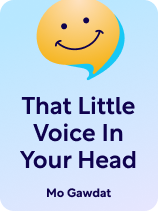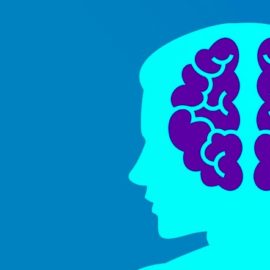

This article is an excerpt from the Shortform book guide to "That Little Voice In Your Head" by Mo Gawdat. Shortform has the world's best summaries and analyses of books you should be reading.
Like this article? Sign up for a free trial here.
What are Mo Gawdat’s “programming” tips for more happiness? How can you make your brain process information better?
In That Little Voice in Your Head‘s section on happiness, Mo Gawdat discusses four tips to help your brain process and respond to information in ways that lead to happiness. By thinking of your brain as a malfunctioning computer, you can logically reprogram it to be happier.
Read below for Mo Gawdat’s tips for programming your brain for unlimited happiness.
Programming Tip #1: Observe the World Around You
When discussing happiness, Mo Gawdat recommends you actively observe the world around you and intentionally spend your time and attention on positive things. The purpose of this is two-pronged: First, focusing your mind on the details of the world around you will help direct your thinking to positivity rather than rumination (avoiding Error #4). Second, focusing on the world around you can lead to happiness because you’ll notice more things to be grateful for.
For example, be aware of beauty as you walk to work and snap a picture when you find it. Intentionally looking for beauty accomplishes three things: 1) It keeps your mind busy so you can’t ruminate, 2) it allows you to focus on positive things that make you happy rather than sights that annoy you (like litter), and 3) it helps you appreciate small details about your neighborhood that you wouldn’t have noticed before—even more to be happy about!
(Shortform note: Along the same lines as Gawdat’s idea to notice and photograph beauty, Cesar Kuriyama created the app 1 Second Everyday (1SE), which encourages you to record one second of your life every day and compiles the clips into a video recap at the end of the year. Like Gawdat, Kuriyama’s goal is to help people take control of their happiness by training them to focus on and celebrate the small details of daily life. Further, the app functions as a journal, so if you’re ever feeling down, you can revisit your captured moments to remind yourself of what you should focus on and what you can be grateful for.)
Gawdat explains that choosing to direct your mind is intentional—you must actively set out to do this every day for it to become a habit that can replace the errors discussed in the previous section. He explains that focusing your attention makes you happier because it functions as a form of meditation—and it makes you more compassionate and empathetic.
(Shortform note: One reason empathy and compassion lead to happiness is because they increase social connectedness. Those who feel connected to others are less likely to experience anxiety and depression, and they have higher self-esteem. They’re more likely to trust and cooperate with others, and therefore receive more trust and cooperation in return. Further, those who practice compassion may live longer because compassion combats toxic stress.)
Programming Tip #2: Check Yourself
Gawdat’s second tip to program your brain for happiness is to check how you’re perceiving and reacting to the world around you. This will ensure that you’re only allowing accurate information (inputs) into your brain, that you’re solving problems effectively, and that you’re handling ruminative thoughts before they take control of your mind. (This addresses Error #1: inaccurate thoughts and Error #4: undirected thinking.)
(Shortform note: In The Happiness Trap, Harris agrees that mistaking your thoughts and perceptions for reality (or being in a state of “fusion”) causes unhappiness. To avoid this, you must undergo the four-stage process of “defusion” to separate your thoughts from reality. First, recognize that your thoughts are merely words and images your brain uses to tell a story about what happened—not facts. Second, acknowledge that your thoughts only matter if you judge them as useful—you have the choice. Third, acknowledge that you don’t have to do what your thoughts tell you. Finally, don’t view your thoughts as threats because they’re only words and images—they can’t hurt you.)
Programming Tip #3: Get Into Flow
Gawdat’s third tip to program your brain for happiness is to get into a state of “flow.” Flow is a state of intense, uninterrupted focus where your environment fades into the background, time flies, and your productivity, creativity, and overall performance soar. Gawdat says that reaching flow makes us happier not only because it allows us to direct our mind (avoiding Error #4), but also because of the chemicals our brain releases in this state.
In flow, writes Gawdat, our brain releases norepinephrine, serotonin, dopamine, and anandamide. Norepinephrine triggers flight-or-fight mode and gives us the focus needed to escape danger. Serotonin is the chemical of calmness and happiness and subdues the effects of norepinephrine so that we can get the high focus it provides without the stress and fear we would normally experience. This combination then causes our brains to release dopamine—the happiness chemical. Anandamide is also released, which boosts memory and creativity.
Gawdat says two factors are required to reach a state of flow.
First, to reach flow you must dedicate a block of uninterrupted time to the task. This is because it takes time to reach flow—unless you’re an expert, it’s unlikely you’ll be able to sit down and immediately reach this state. Rather, as you work, the task will seem harder and harder until your focus peaks and you enter flow—at this point, the task will seem a bit easier, and you’ll get a better grasp of how to accomplish your goal. Further, every time you’re interrupted, you’ll break flow and have to take time to get back into it—avoid this by making sure in advance that you won’t be interrupted.
Second, a task must be difficult but doable in order for you to reach a state of flow. Gawdat says easy tasks don’t require your full attention, and therefore your brain has room to wander. To reach flow, the task you’re performing must command your full attention and abilities. However, if the task is too hard, you’ll be unable to progress and therefore unable to reach flow.
Programming Tip #4: Give to Others
Gawdat’s final tip for programming your brain for happiness is giving to others. He says that of all the tips he offers, giving and making others happy has brought him the most happiness. There’s no concrete explanation for why giving makes us happy, but our evolutionary instinct may play a part. Gawdat suggests that we take pleasure from giving to others because humans must support each other to survive—if we feel good when giving, it ensures we’ll help those who need it and the species will continue.
(Shortform note: Another reason helping others may bring us happiness is that it instills us with purpose. In Grit, Angela Duckworth argues that there are only two ways people find happiness—through pleasure or purpose. Pleasure is happiness derived from benefiting yourself, while purpose is happiness derived from benefiting the greater good. Giving to others would arguably produce the most intense happiness from purpose because it’s one of the most direct ways to benefit the greater good—when you do something for someone, you see the impact of your action immediately.)
Gawdat makes a few recommendations to practice giving to others.
First, give away the things you don’t need—clothes, items, money, and so on. As we discussed in Error #2, the more things that you have, the more power that those things have over your happiness. So, figure out what you can spare, and give it to others who need it more. For example, if you never wear your mother’s old ring, and it sits inside a box in your closet, you could give it to a friend who wants to propose to their partner but can’t afford a ring. If you never look at the ring, you won’t miss it, but for your friend, it will mean the world.
(Shortform note: Going through your things to determine what you can get rid of can be difficult and time-consuming. Other experts offer a few tips to make the process easier. For example, first start with things that bother or distract you—for example, the drawer full of free t-shirts you’ve collected from events but never wear. Further, set a timer for when you’re clearing your space to help prevent you from taking too many trips down memory lane that draw out or make the process more difficult.)
Second, says Gawdat, practice the art of giving to others what you give to yourself. For example, if you buy yourself a strawberry donut, buy an extra one and give it to your coworker. You don’t have to do this all the time, but try to do it once or twice a week.
(Shortform note: One easy and popular way to follow this recommendation is to pay for the order of the person behind you in the drive-through lane. This phenomenon has been known to cause a chain reaction—in one instance, a chain of 900 people paid for the order of the next person at a Dairy Queen drive-through.)

———End of Preview———
Like what you just read? Read the rest of the world's best book summary and analysis of Mo Gawdat's "That Little Voice In Your Head" at Shortform.
Here's what you'll find in our full That Little Voice In Your Head summary:
- How to understand and program your brain to produce positive actions and emotions
- The four processing errors that cause our brains to produce unhappiness
- Why you should get into the flow state more often






